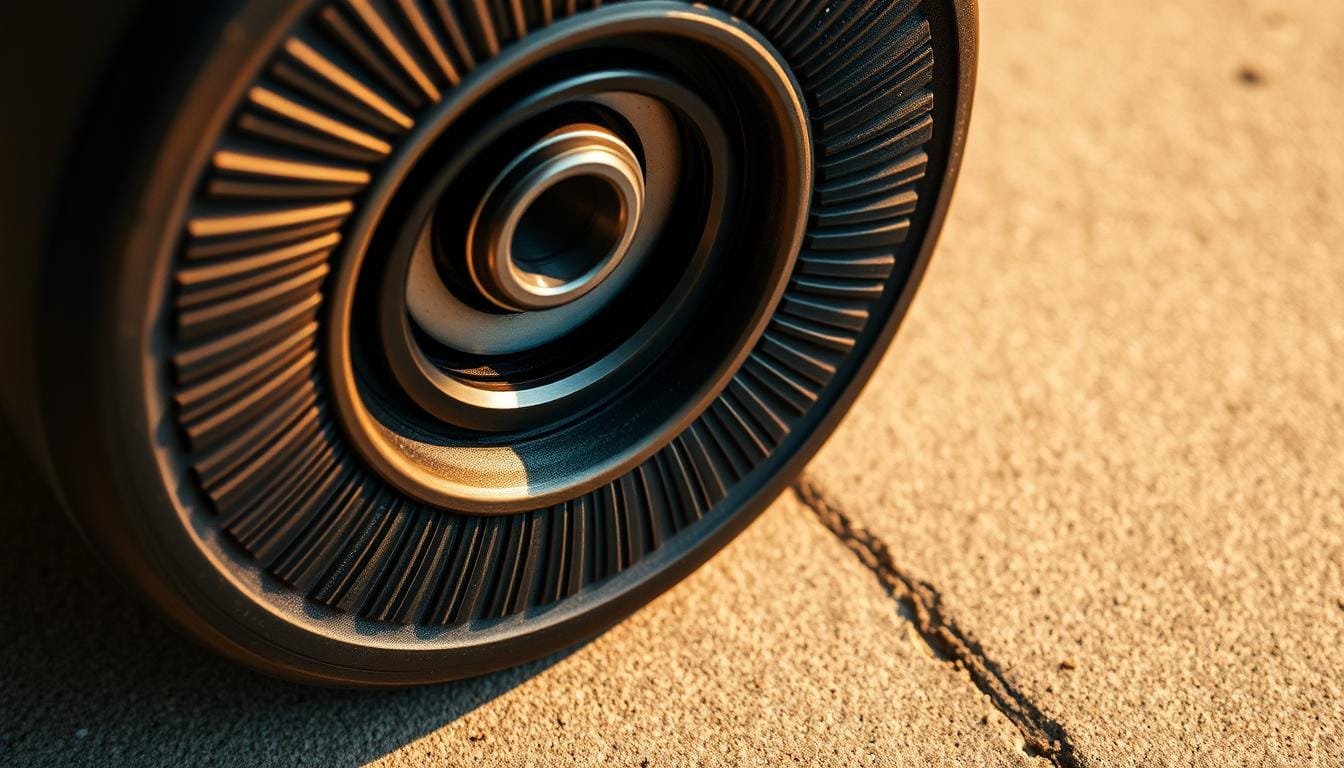In street skating, the wheels you choose can really affect how you skate. They are especially important when doing tricks and skating on streets. The hardness of the wheels is measured using the Durometer A Scale. Higher numbers mean harder wheels. Hard wheels are preferred by skilled skaters because they’re fast, bouncy, and great for sliding. This makes them perfect for performing tricks.
Hard skateboard wheels have a hardness from 96A to 104A. Skaters who skate professionally usually pick wheels that are between 100A and 104A. Brands like Bones Wheels and Spitfire are top choices. They make hard wheels that are known for being some of the best you can buy.
The hardness of your wheels changes how your skateboard feels and how well you can do tricks. Whether you’re an experienced skater or just starting, it’s crucial to know how wheel hardness affects skating. You can check out some skating tips here.
Key Takeaways
- Hard skateboard wheels range from Durometer 96A to 104A.
- Professional skaters prefer wheels with a durometer of 100A to 104A.
- Brands like Bones Wheels and Spitfire offer highly rated hard wheels.
- Harder wheels increase speed, sliding capabilities, and precision in tricks.
- Choosing the right wheel hardness can enhance your street skating performance.
Understanding Skate Wheel Hardness
Knowing how hard skateboard wheels are is key to good performance on different surfaces. Wheels are measured using the durometer scale. This scale shows how hard a wheel is and affects your skating. The *A scale* is used a lot, going from 0 to 100. The higher the number, the harder the wheel.
Wheels for street skating usually have a hardness from 99A to 101A. These harder wheels work well for tricks and smooth places. On the other hand, softer wheels that score between 78A and 90A are great for cruising and bumpy areas. They give a smoother ride by taking in more bumps.
Some makers like Bones Wheels use the *B scale*. It’s 20 points less than the A scale. For example, 82B is the same as 102A, meaning these are super hard wheels perfect for pro street skating. Below is a table to help understand different durometer ratings and what they’re for:
| Durometer Rating | Application |
|---|---|
| 104A / 84B | Harder than hardest |
| 101A | Very hard street/park wheel |
| 99A | Medium harder street/park wheel |
| 92A | Medium soft all-terrain wheel |
| 87A | Soft street cruiser/filming wheel |
| 78A | Super soft cruiser/longboard wheel |
The size and type of skateboard wheels also matter a lot. Street skaters like wheels from 50mm to 56mm for better control. But cruiser and longboard wheels are bigger, from 60mm to 75mm, offering more grip and steadiness.
Choosing the right wheel hardness, size, and type depends on how and where you skate. Knowing these details helps you pick the best wheels for a great skating experience.
The Advantages of Hard Wheels for Street Skating
Hard skateboard wheels are key for street skating goals. They help perform technical tricks like ollies and nose slides well. With a durometer rating between 95A to 101A, they offer the right precision and quickness on smooth surfaces. This makes doing slide maneuvers in the skatepark easier.
Hard wheels are also durable, which is great for street skating. They don’t get flat spots easily, unlike softer wheels. This means they can go faster on concrete, improving your skating in streets and parks. Learn more about comparing hard and soft skateboard wheels and their differences.
In city skating, hard wheels’ lower grip makes slides smoother and transition maneuvers more controlled. This is helpful for tricks like blunt slides where you need a lot of control. Experts say wheels rated 99A or higher are best for top performance and trick success on pavements.
The Drawbacks of Hard Wheels
Street skaters love hard wheels for their fast speed on smooth places. But, it’s smart to know the limits of hard wheels before you choose. These wheels, which measure from 95A to 101A in hardness, are great for skateparks and even streets. However, what if you skate on rougher grounds?
One big downside of hard wheels is how they don’t absorb shocks well. On uneven surfaces, they make the ride bumpier compared to softer wheels (70A to 87A). This can make it hard to keep your balance and skate smoothly, as you feel every bump and crack.
Besides the bumpy ride, hard wheels also don’t grip as well. Soft wheels do better on rough surfaces because they hold on tighter. But harder wheels (101A and up) slip easier, especially on slick or wet grounds. This means skaters have to think hard about where they’ll be skating to dodge these problems.
Also, think about how hard wheels do when filming. If you want to make smooth, movie-like skate videos, hard wheels won’t do the job well. The shaky and unstable footage is a big downside, making softer wheels the better choice for filming.
Even if you try wheels that are a bit softer, like 88A-95A, they might not fix everything. If you’re looking at different wheels, it’s smart to look for advice from skilled skaters. Maybe, longboard wheels would work well for you. Picking the right wheels really can make skating much better.
Ideal Conditions for Hard Wheels
Understanding the ideal settings for hard wheels can greatly improve your skateboarding. These wheels, with a hardness from 96A to 101A, work best on smooth surfaces. Places like skate parks, clean streets, and well-kept urban areas are perfect.
Skate parks are top choices for hard wheels because of their smooth surfaces. They allow fast moves and easy slides. Soft wheels can’t do this as well. For street skating, hard wheels help with precise technical tricks.
Hard wheels also last longer than softer ones, which are best for cruising. They don’t wear down as quickly on smooth surfaces. The Skateboard Wiki on Skatedeluxe says this saves money on replacements and maintenance.
Wheel size is important too. For street skating, small wheels (50mm to 53mm) are best. They improve balance and control. But in skate parks, go for 54mm to 56mm wheels. They’re good for both street and park skating.
If you skate on smooth surfaces and like doing tricks, choose hard wheels. They offer speed, precision, and a better skateboarding experience. Hard wheels can really make a difference in the right places.
Personal Preference: Finding Your Balance
Skateboarding is not just about skill, but also how you express yourself. When you pick out skateboard wheels, knowing what you like makes a big difference. You have to consider your skating style and where you like to skate, whether it’s the city or a skate park.
Wheels come in sizes from 48mm to 70mm. For street skating, the best sizes are between 52mm and 54mm. These sizes help you do tricks and skate smoothly. For park skating, go for bigger wheels, between 55mm and 58mm. And for just cruising around, get wheels that are 59mm or larger. They’re great for rough surfaces.
| Type of Skating | Recommended Wheel Diameter |
|---|---|
| Street Skating | 52mm – 54mm |
| Park Skating | 55mm – 58mm |
| Cruising | 59mm+ |
The hardness of your wheels also plays a role in your skateboarding. Hard wheels, with a durometer between 98a and 99a, are good for concrete and asphalt. They suit advanced tricks and skaters. If you’re just starting or skate on rough ground, go for softer wheels, between 78a and 87a. They absorb shocks better.
Picking the right wheels means thinking about your style and learning some tech specs. Matching your wheels to how and where you skate improves your skating. It also makes it more fun.
Tips for Transitioning to Hard Wheels
When you switch to hard wheels, your skateboarding changes a lot. Preparing well can smooth out the process. Hard wheels affect your speed and grip, so it’s important to know what to expect. Here’s some advice to help you adjust.
Start slowly. Don’t go for the hardest wheels right away. Move up through stages of hardness. For example, if you’re using soft wheels rated 75A-87A, try going to wheels rated 88A-95A before going to 96A and higher. This step-by-step approach helps you adjust your skills gradually.
Pay attention to wheel size during this change. If you’re used to big wheels (60mm+), consider smaller wheels (50-53mm) for starters. Smaller wheels are quicker and give you better control. This is helpful as you get used to the speed and grip of hard wheels.
Here’s a comparison to help you choose your setup:
| Wheel Size | Application | Benefits |
|---|---|---|
| 50-53mm | Street & Park Skating | Quick Acceleration, Responsive |
| 54-56mm | Mixed Uses | Balanced Speed & Control |
| 60mm+ | Longboarding & Downhill | Smooth Ride, High Speeds |
Switching to hard wheels means changing how you ride. Hard wheels react differently on various surfaces. You’ll need to move more carefully and focus on balance and foot placement.
Expect to need some time to adjust. The new feel of reduced grip and more speed may be surprising. But with regular practice, especially on familiar grounds, you’ll get better. Slowly add more challenging surfaces as you improve.
Don’t forget to rotate your wheels to wear them evenly and make them last longer. Keeping up with this maintenance helps keep your ride smooth as you get used to the new wheels. Choosing high-quality wheels might cost more but gives better performance and lasts longer.
In the end, moving to hard wheels adds speed and makes tricks easier. With this advice, you can make the switch smoothly and get the most out of your new wheels.
Conclusion: Are Hard Wheels Right for You?
Choosing the right skate wheels can be tricky. It gets especially tough when deciding between hard and soft wheels. Hard wheels, like those with a 99d or 101a hardness rating, are great for street skating. They make doing technical tricks and slides easier because they don’t grip as much and go faster. But, they are not as good on rough surfaces and don’t absorb shocks well.
When thinking about skate wheel hardness, it’s important to know when to use hard wheels. If you mostly skate on smooth surfaces and do technical tricks, go for top brands like Bones and Spitfire. Their Spitfire Formula Four and Bones STF wheels are very popular. For those who skate on different types of surfaces, wheels like Powell Dragon Formula or Bones X-Formula might work better. They provide a nice mix of grip and slide.
Choosing the right wheels comes down to what you prefer. Think about where you usually skate and how you like to skate. Use what you’ve learned from this guide to help you decide. Whether you want speed and slide, or stability and grip, this information will help you tailor your skateboard. Always remember, the best skateboard fits your unique style and brings you joy and performance.

I’m John Peterson, a passionate skater, blogger, and lifelong enthusiast. I’ve been skating for over 9 years and have gone on to write a blog dedicated to the sport of skating and its culture. Through my blog, I strive to share my knowledge and experience of the sport with all who are interested. From beginner tips, tricks, and equipment reviews to interviews and event coverage, I cover it all. So read my blog as I explore the wonderful world of skating!

